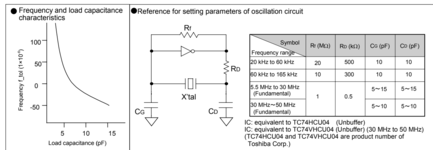e-music
Member level 5
Hi,
If this is not the place to ask this, please move at will!
The following is a CMOS Crystal Oscillator Circuit that generates a square wave:

I will use this circuit to supply the clock needed for a legacy device that accepts clocks in the range of 10~40 Mhz. Is this the best way to do it? What is the formula used to calculate C, R1, and R2 for a 40 Mhz crystal?
Regards,
Zaher
If this is not the place to ask this, please move at will!
The following is a CMOS Crystal Oscillator Circuit that generates a square wave:
I will use this circuit to supply the clock needed for a legacy device that accepts clocks in the range of 10~40 Mhz. Is this the best way to do it? What is the formula used to calculate C, R1, and R2 for a 40 Mhz crystal?
Regards,
Zaher
